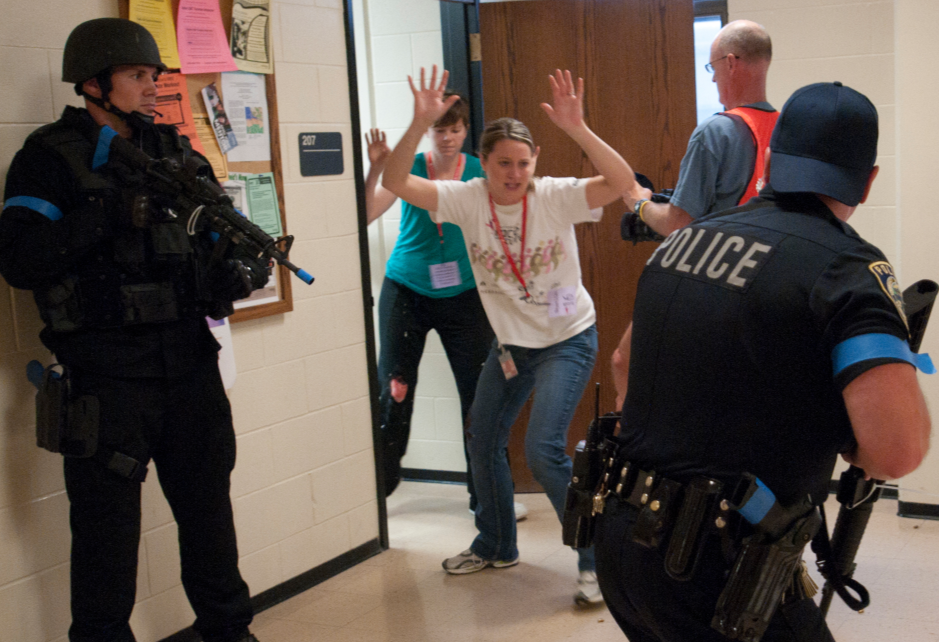
A few seconds separated the fates of Paul Erickson and Sunil Narumalani during the May 11 terrorism exercise at UNL.
Playing professors in neighboring classrooms on the second floor of Oldfather Hall, both Erickson and Narumalani were leading lectures to keep volunteer "students" distracted.
"We didn't hear a thing. Then a guy walked in and he started shooting," said Erickson, academic technology and middleware coordinator for Information Services.
At the same moment, out in the hallway, a second gunman started firing a simulated shotgun. The sound of gunfire put Narumalani and a couple of his students into motion.
"I heard the shots and we were able to get to the door and get it closed before the gunman stepped in," said Narumalani, associate dean for academic programs in the College of Arts and Sciences. "We held the door shut and I had the students stay together in a corner along the same wall as the door."
No one in Narumalani's classroom — room 209 — was shot. Fates differed in room 207, the first room targeted in the drill.
As the gunman stepped in the room, Erickson said time slowed. The blue plastic gun was directed toward students who were diving for cover. In the moment, Erickson reacted.
"I actually had a pretty good angle on the guy," he said. "I started running at him, but he didn't let that happen."
The gunman turned, pointed the gun at chest level and said, "bang." Erickson was then counted among the dead, and one of the first victims of Terrex11.
"It all happened so fast," Erickson said. "We didn't have any warning, no time to react. It was over in seconds."
The terrorism simulation was a full-scale emergency training exercise organized by the Nebraska Emergency Management Agency. The exercise involved hundreds of volunteers, including participants from UNL, Lincoln Police and Lincoln Fire departments, Lancaster County Sheriff, Nebraska State Patrol, Nebraska Department of Health and Human Services, FBI and Bryan/LGH and St. Elizabeth hospitals. This was the ninth full-scale exercise organized by NEMA and the first involving an attack on a college campus.
The scenario included two shooters on floors two through seven of Oldfather Hall. The gunmen killed 30 people and wounded about 40 more.
Carl Oestmann, assistant UNL police chief, said the two pretend gunmen were "neutralized" in a stairwell within minutes of police arriving at the scene.
The exercise was designed to test the response of various police and rescue agencies, communication between those agencies and the public, and medical capacities of area hospitals.
"This was a very valuable drill we had today," said Owen Yardley, UNL police chief, at the exercise's conclusion. "Through our debriefings, we've identified strengths and some areas that still need some work. But, overall no major problems were uncovered."
Yardley said communication between the emergency responders was solid. He said that was expected because the agencies use the same radio system and work together for eight (or more) home Husker football games annually. Yardley also said online messaging of events — such as UNL websites and social media sites like Twitter — showed potential as ways to deliver messages to the public.
"Communication is always the biggest problem when you deal with this type of situation," said Yardley. "Though it was effective today, there are still some areas for improvement."
NEMA will provide detailed reports on the exercise to the university and other drill partners. Those reports will be used to identify areas of strength and weakness in the response.
"In the last 10 years, this type of event has happened in places we never expected," said Yardley. "We hope it never happens here, but if it does, we want to be sure we are prepared. That's why a drill like this is so useful."
Back in Oldfather, Erickson transitioned into a second role and went to the Devaney Center to act as a parent seeking information on the fate of his child. In room 209, about half of Narumalani's 20 "students" were replaced by actors with simulated wounds.
While other acting professors left the rooms with the non-injured, Narumalani opted to stay and help the "wounded."
"I was told that I was the few professors who stayed behind with the students," said Narumalani. "I never considered leaving. It was instinctive to me to stay. I felt a sense of responsibility to be there and help those students who were wounded."
While the students acted like they were injured, Narumalani provided comfort and helped where he was needed. He even performed simulated CPR to one student.
"I think overall, the drill was quite well done," he said. "The actors did a very good job role playing. It was a very enlightening process — but one I hope we never have to go through for real."
- Troy Fedderson, University Communications